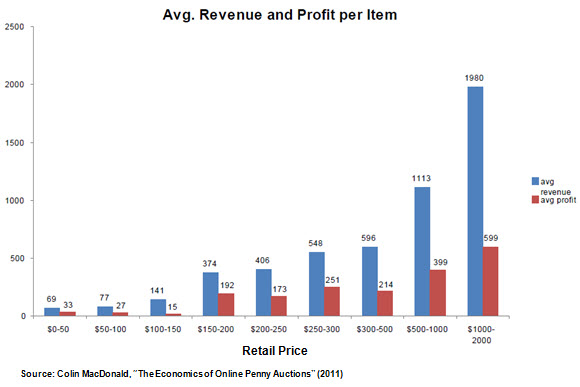Can you get an iPad 2 for $50? For real?
Have you ever seen the banner ad saying “get an iPad 2 for only $50!” I always wondered how can an iPad whose retail price is over $700 can be sold at a price which is almost 90% cheaper than the retail price. Moreover, the left over time is less than a minute so it really allures consumers to at least try to bid for the fancy products that have a great amount of discount. It seems that if the online penny auction site sells products at significantly low prices, the firm which runs the site cannot make any money out of it. In order to figure out how the auction site earns the money, we need to understand how the bidding is done.
There are many forms of online (penny) auction sites but the two of the most popular among them are penny auctions and reveal auctions. Penny auction is exactly the same as the ascending bid, which we learned in class. This is also called as English auction. In penny auction, the bidder pays a certain amount of money to place a bid(let’s say 50 cents) and the price of the product rises by 1 cent, and remaining auction time also increases. Whoever places the highest bid in the time limit wins the product. Reveal auction is also known as reveal price auction or dutch auction. The auction price starts from the recommended retail price, which is almost the same as the retail price of the product. The price is hidden at first and participants pay a certain amount of money to view the price. Then the price goes down and the participant has to decide whether to buy the product at that price in 10 seconds.
Back to the main question: How the business earns the profit under this auction system. According to the paper published by MacDonald(2011), less than 1% of bidders actually won the product. 99% of bidders paid for nothing. Their money basically subsidized the auction winner and ultimately the business. If we look at the graph below, the margin that the business earns out of the auction is significantly large. This is the data for one of the online penny auction giants Swoopo.com
 We can point out that the business makes more profit as the price of the product increases. The profit margin for the product price ranging from $1000-$2000 is almost 50%. Even if the business sells the product at a significantly low price, only 1% of the bidders can actually win the product. The other 99% bidders make up the discount and even more to generate an excessive revenue for the firm. Thus, the luring price of iPad or Macbook for only $50 is at most an illusion.
We can point out that the business makes more profit as the price of the product increases. The profit margin for the product price ranging from $1000-$2000 is almost 50%. Even if the business sells the product at a significantly low price, only 1% of the bidders can actually win the product. The other 99% bidders make up the discount and even more to generate an excessive revenue for the firm. Thus, the luring price of iPad or Macbook for only $50 is at most an illusion.
What about the reveal auction sites such as peeka.com? The website sells gift cards for starbucks, macy’s, bestbuy and so on. For only 20 cents I can peek at the price and can buy the product at a discounted price. For example, $50 best buy gift card is sold at $42.20, 13% lower than the original price. However, if I peek at the price, the price only drops 10 cents which is smaller than my payment, 20 cents. Even though the business offers about 5-10% off from the original price, it is going to make a profit when 25 bids are made to buy the product. The discount amount is not as appealing as the online penny auction site, but still the business makes a lot of profit out of bidders’ pockets.
The business need to create value out of given resources. In other words, value added to the product is really important quality for the business. However, online penny auction sites only create little value to the society. They just take money from one bidder’s pocket to other bidder’s pocket and to themselves. No innovative thinking is needed to make the auction, so we should be careful when we see the alluring ads saying “you can get an iPad for only $50. The auction is going to end in one minute so you should hurry up!” We need to fully understand how the online penny auction runs and think about the cost and benefit of participating in this auction.
sources
“The Flawed Economics of Online Aucton Sites”: http://thepricingjournal.com/2011/07/07/the-flawed-economics-of-online-auction-sites/
“The Economics of Online Penny Auctions by Colin MacDonald (2011)”: http://soundideas.pugetsound.edu/cgi/viewcontent.cgi?article=1028&context=summer_research&sei-redir=1#search=%22economics%20online%20penny%20auctions%22
“What is Penny Auction?”: http://www.pennyauctionwatch.com/2009/05/what-is-a-penny-auction/
